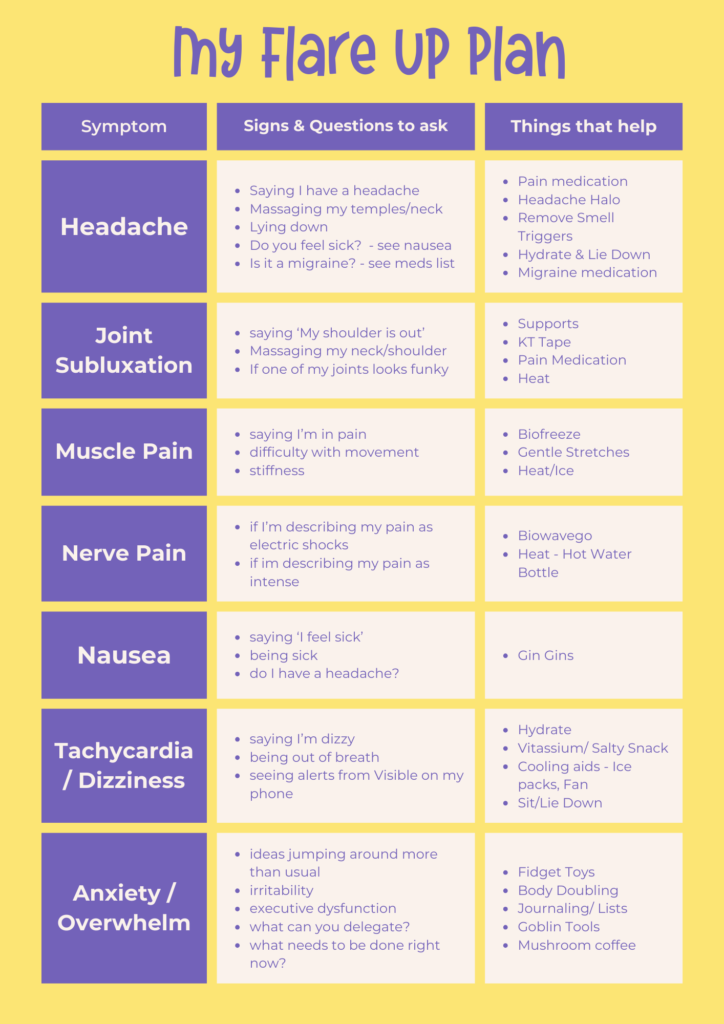Living with a chronic illness means that flare ups can be unpredictable and challenging to manage. When symptoms intensify, it can be hard to think clearly about what helps. I often find myself struggling with a worsening headache all day, only to have my partner remind me of the things that actually ease the pain. That’s where a flare up plan comes in handy!
A flare up plan is a simple but effective tool that helps you manage symptoms more efficiently and communicate your needs to others—without using extra energy when you’re already struggling. Here’s how you can create one for yourself.
What is a Flare Up Plan?
A flare up plan is a structured guide that outlines your symptoms, their warning signs, and the most effective treatments or actions to manage them. This plan can help you and your support system respond quickly when symptoms worsen.
Step 1: Create a Table with Three Columns
Your flare up plan should be structured into three main sections:
- Symptoms – List the primary symptoms that tend to flare up for you. This could include pain, fatigue, migraines, POTS symptoms, joint subluxations, anxiety, or anything else that significantly impacts you.
- Signs & Questions – In the second column, note the signs that indicate you’re experiencing each symptom. Also, include questions that might help you or others identify what’s going on.
- For example, when I experience anxiety, I may not immediately recognize that I’m overwhelmed. But signs like rapid, scattered thoughts or struggling with executive function can indicate it. This might prompt my loved ones or support workers to ask, What are the immediate tasks? What can be delegated?
- Similarly, if I have a headache, my flare up plan includes the question, Do you feel sick? This helps me determine whether I’m experiencing a migraine rather than a standard headache, meaning I may need different treatment.
- Helpful Actions & Treatments – The last column is where you list everything that helps you manage each symptom. This could be medication, mobility aids, sensory tools, or specific techniques.
- For instance, for headaches, I list my headache halo, pain medication, hydration, and resting in a dark room.

Step 2: Keep Your Flare Up Plan Accessible
A flare up plan is only useful if it’s easy to find! Place it somewhere visible and accessible to both you and those who support you. I keep mine on the fridge, but you could also store it on a pinboard, in a medical binder, or even digitally on your phone.
Download Your Free Flare Up Plan Template!
To make it even easier for you, I’ve created a free Flare Up Plan template that you can download and fill in! This template is designed to help you quickly map out your symptoms, signs, and helpful actions so you’re always prepared.
Click the link below to download your free template and start building your personalised flare up plan today!
Why a Flare Up Plan is Useful for Managing Chronic Illness
- Helps you act quickly when symptoms arise without having to think too much.
- Enables others to support you effectively without you needing to explain everything while unwell.
- Reduces stress and anxiety by providing a structured approach to managing your health.
- Improves symptom tracking by helping you identify patterns in your health over time.
Frequently Asked Questions About Flare Up Plans
1. Who should use a flare up plan?
Anyone with a chronic illness that involves unpredictable or worsening symptoms can benefit from a flare up plan. It’s especially useful for those with conditions like fibromyalgia, POTS, EDS, migraines, or anxiety disorders.
2. How often should I update my flare up plan?
You should update your flare up plan whenever you find new symptom triggers, treatments, or management strategies that work better for you.
3. Can I use a digital version instead of a printed one?
Absolutely! While a printed version on the fridge or in a binder is great for quick access, a digital version on your phone or tablet can also be very convenient especially when you are out of the house. You could also put a copy in your Flare up bag
Will You Create a Flare Up Plan?
Do you think this method would work for you? If you already have a flare up plan, I’d love to hear how you structure yours! If not, will you give it a try?
Let me know in the comments or share your experience with me on Instagram!
By implementing a well-structured flare up management plan, you can take better control of your symptoms and make sure you—and those around you—are prepared when you need support the most.




